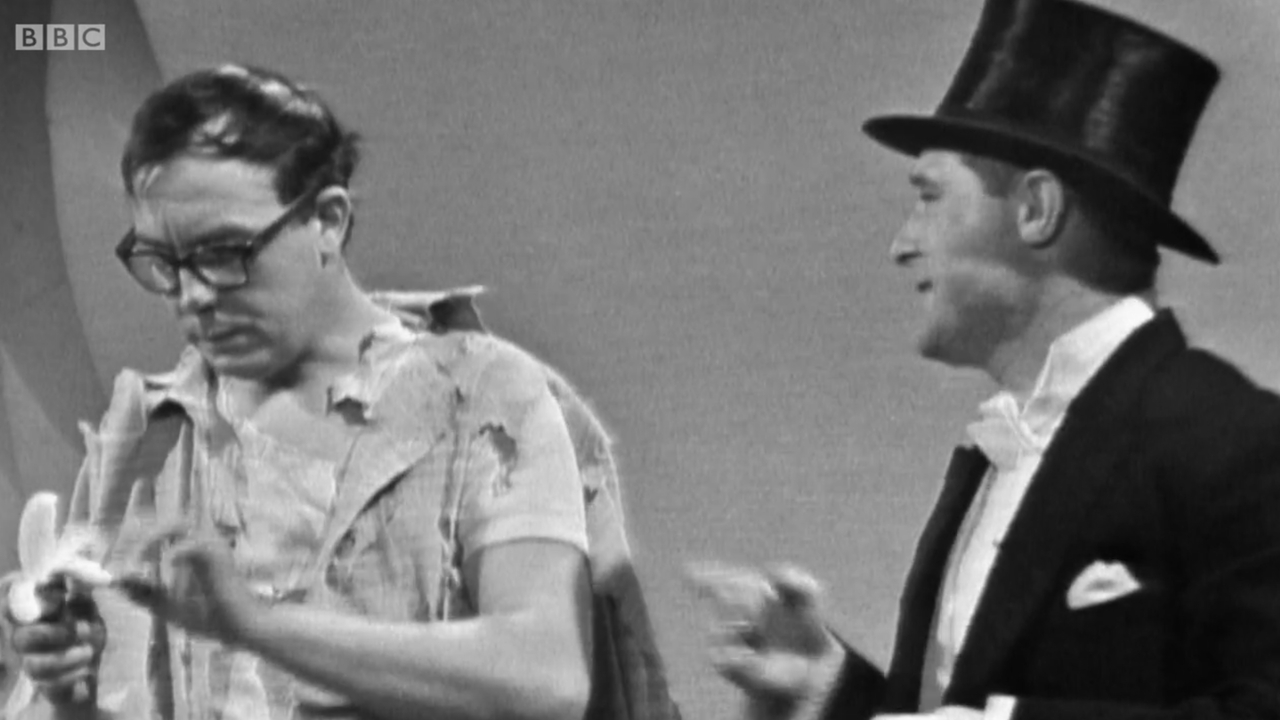
Replay: It doesn’t matter if you don’t necessarily know the names of the act involved, the BBC’s work in restoring some lost footage of the comedy duo Morecambe & Wise is video science at its most extreme cutting edge.
Okay, first things first: in the UK Morecambe & Wise, Eric Morecambe & Ernie Wise, are one of the most revered acts that every trod the boards or performed in front of a TV camera. The phrase ‘national treasure’ is often over-used, but these two are universally loved in death as they were in life. And while some of their material has dated slightly, as has that of many light entertainment stars of the 1970s, a lot of it is still very, very funny.
Even better, their legacy hasn’t been tainted by tales of inappropriate behaviour. These are 70s childhood icons that the whole family can still enjoy without having to explain all manner of unpleasant subjects to your children.
All this is slightly by the by, but does put into context why the BBC is spending such an inordinate amount of effort in restoring some early footage of the pair that was previously thought lost.
1968 and all that
You can read the full story at the BBC R&D blog, but its genesis lies in the fact that broadcasters rarely kept any videotape of programmes transmitted in the 1960s as reusing the tapes was an economic necessity. Some material though was ‘telerecorded’ onto 16mm film and these films - usually black and white - would be sent off to broadcasters around the world that wanted to screen the shows.
Once used they were then sent to landfill. This is why there aren’t many of them around.
However, in 2012 a rare film can continuing the second ever episode of The Morecambe & Wise Show was found in the film vault of Nigerian broadcaster RKTV, along with some early Dr Who episodes. The problem was that it was in a seriously bad condition, so bad in fact that the British Film Institute recommended it should be destroyed due to the sheer amount of acid vapour coming off the degraded acetate inside.
Enter the Antikythera Mechanism
In 2012, scientists used X-ray tomography to examine the Antikythera Mechanism, a priceless and astonishingly complex navigation computer found in a shipwreck that dated from the time of Archimedes. Essentially they uncovered its workings a layer at a time working from the inside out, all of which led archiving expert Charles Norton to start to wonder whether it would be possible to use the same techniques on degraded film.
“In theory, this high silver content [of film] would work well for X-ray Tomography,” he writes. “All tomographic methods look for the difference in X-Ray opacity between two substances. In the case of Morecambe and Wise, we are looking at the difference between the translucent plastic layer and the high metal content in the emulsion layer. If the theory was sound then the silver content should light up in the scan.”
Having concluded that it was likely impossible, they set about doing it.
To the various team members’ surprise the silver showed up well. The challenge then lay in tracking the layers of the tightly-wound film, which they developed software to do by tracing the silver images themselves, and then using more software to divide the film into individual frames using the sprocket holes as reference.
But with tests on smaller reels of material successful enough to give hope, the problem then moved on to the sheer size of the reel and the realisation that in order to process it effectively it would have to be chopped into much smaller chunks, around 2.5cm. This was done via laser before 5000 X-ray images were taken of the 37 individual blocks and then reconstructed in 3D space. A further program was written to follow the contours of the film and, against any initial hope or expectation, images of Eric & Ernie started to appear.
Stitching it all together
The difficulty next lay in getting the images into some coherent order. BBC R&D’s Adam Wiewiorka takes up the story: “A quick look at some cross-sections revealed a number of interesting features such as curvature in all directions, air gaps, areas filled with fluids of various density, cracks and distortions of the image, burn marks from laser cutting, discontinuities at perforations holes and so on.”
There was enough ambiguity in the voxels (3D pixels) of the images from the scans that it was decided the best route forward was to try and detect the mid-grey plastic backing of each layer of film. Once one of these was successfully locked down, the hope was that surrounding layers should follow roughly the same curvature and would be much quicker to isolate.
It was a nice idea that ran into some practical problems, notably that during the 24 hour scanning process temperature variations had resulted in a shifting of some of the voxel values. And once the team had somewhat heroically managed to produce 5000 image files from the scans, they faced the problem that not all blocks were uniform and a degree of manual alignment was necessary to line up the frames.
Which is roughly where the project is now. Nearly six years after first being discovered, and 50 after first being filmed, 6156 image files in the right order have been handed over for the job of video recovery and processing. Again, the degree of damage sustained while in the archive means that this is not something that can be left to algorithms and is going to need the frequent intervention of skilled human beings to make sense of.
The BBC R&D blog posts, which again can be found here, contain a lot more technical detail that we’re perforce skipping over and are all in all well worth reading. One thing they don’t mention though is the upcoming 50th anniversary, but presumably that’s some form of driving factor behind all this heroic effort. The actual initial broadcast date of Episode 2 of The Morecambe & Wise Show was September 9 1968. A little under nine months to go then…
Tags: Post & VFX



Comments